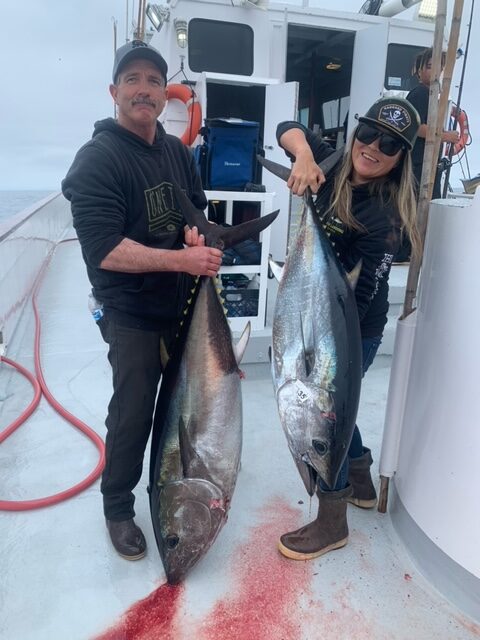
BY MERIT McCREA
Over the past couple weeks, it’s been hell for skippers in the offshore fleet to keep anglers on fish. While it’s largely been successful, it hasn’t been easy, hours of eye strain looking for a likely kelp to save the day, followed by an all-night search for a major meter mark that might put a bluefin or two aboard on the big gear.
But that all changed and the fleet is again on biting bluefin as of press time. The past day or two it’s been limits on 50- to 100-pound class fish, still mostly at night.
This fish, it’s centrally located just 50 to 60 miles from every harbor from San Pedro to San Diego. The San Diego fleet is already on it. Overnight boats from Pedro, south are switching gears to the big stuff and heavy iron.
There are some daytime bites but the bulk continues to be a night bite, starting just after dark – classic. And it all changed Saturday night.
Capt. Aliyar Nabi posted, “We left yesterday on a two-day trip, and we had a very successful fishing session last night. We caught 50- to 100-pound bluefin tuna. We managed to catch 64 fish from yesterday until this morning. The opportunities have been great, with plenty of nice schools of fish around.”
As for what’s been getting bit, again it was the 300-gram knife jigs and the sinker rigs with live bait.
Often it’s all about speed when the boat pulls up on a spot – get your gear down before the squirt out from under the boat and mosey on.
Sometimes the fish will stick and although they’re not right under all the time, they skirt around not far from the boat, charging under from time to time.
Anglers sit and soak, and often just hanging the jig does the trick as well as anything. Sometimes the fish really want to grab it as it falls though, so you’ll want to wind and drop repeatedly.
So say you’ve been doing this for a while, then the skipper says excitedly, “240 feet, they’re solid.” What do you do? You no longer have a very precise idea how much line it out, for all the winding and dropping, the bit of scope in your line.
One simple fix for this is Izorline MC braid, a different color every 100 feet. Given having learned what color is which depth and accounted for whatever length of mono is on top, you can quickly adjust.

However if you don’t have that, then maybe the best bet is to drop down a bunch and wind back up two bunches so hopefully you pass your jig through the fish in the process.
Or you can wind all the way back up and drop down fresh.
What about hooks? Often the factory hooks aren’t the best you can have and the more experienced anglers will have replaced them with some top-of-the-line models.
I watched Larry Brown’s crew on the Game Changer. They’d switched out with a pair of heavy-duty, larger assist hooks on the top of the knife, and placed a giant, sticky-sharp treble on the bottom, not sure of the make but the thing appeared to have a 2-inch diameter.
Hooked fish came up with the assist hooks in their mouth and that gnarly treble embedded on the outside of their face somewhere pinning their mouth closed, gills bound tight.
Sometimes a fish will refuse to pull line, and just dog around deep. These are the toughest fish and you just have to slug it out.
Most times a fresh one will shake, rattle and roll down there for a minute, then take off for the horizon. That’s the best. Once he’s way out there, just let him stay out there. Relax but keep the line taught.
After a few minutes the fish will swim back your way, the easy way for it. You’ll have to wind fast to keep the tension.
Once straight down it’s time to go to work. Hopefully by then the coast has cleared considerably and there’s a lot less chaos along the rail.
Put the rod on the rail and pick up line every chance you get, half a turn at a time with each tail beat. The ideal spot will be about 2/3 of the way to the bow, right at the forward edge of the cabin, well away from the crowded aft and the running gear under the stern.
There you can usually stand your ground as your fish circles, most of the other nearby lines will be out away from the boat. Have your left hand on top of the reel as you turn with your right, rod on the rail.
Watch the rod tip. Never let it straighten. If it starts to at all, take a turn or part of a turn to keep it well bent.
A 100-pound-plus fish will pretty much have to be high and dry as it circles out away from the boat for a crewman to sink a gaff in it.
The trick is to stick it in the head or chest and keep its head out of the water. If the fish gets its head down it can kick a crewman’s ass while he hangs on, elbows on the rail and prays the gaff hook doesn’t tear out.
Stop winding and be ready to follow the crewman down the rail to the gate where other crew will get additional gaffs in it.



